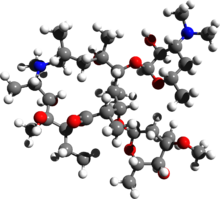 | |
 | |
| Clinical data | |
|---|---|
| Trade names | Zithromax, Azithrocin, others[1] |
| Other names | 9-deoxy-9α-aza-9α-methyl-9α-homoerythromycin A |
| AHFS/Drugs.com | Monograph |
| MedlinePlus | a697037 |
| License data |
|
| Pregnancy category |
|
| Routes of administration | By mouth (capsule, tablet or suspension), intravenous, eye drop |
| Drug class | Macrolide antibiotic |
| Legal status | |
| Legal status |
|
| Pharmacokinetic data | |
| Bioavailability | 38% for 250 mg capsules |
| Metabolism | Liver |
| Elimination half-life | 11–14 h (single dose) 68 h (multiple dosing) |
| Excretion | Biliary, kidney (4.5%) |
| Identifiers | |
| |
| Chemical and physical data | |
| Formula | C38H72N2O12 |
| Molar mass | 748.996 g·mol−1 |
| 3D model (JSmol) | |
| |
| |
| (verify) | |
Azithromycin is an antibiotic used for the treatment of a number of bacterial infections.[3] This includes middle ear infections, strep throat, pneumonia, traveler's diarrhea, and certain other intestinal infections.[3] It can also be used for a number of sexually transmitted infections, including chlamydia and gonorrhea infections.[3] Along with other medications, it may also be used for malaria.[3] It can be taken by mouth or intravenously with doses once per day.[3]
Common side effects include nausea, vomiting, diarrhea, and upset stomach.[3] An allergic reaction, such as anaphylaxis, QT prolongation, or a type of diarrhea caused by Clostridium difficile is possible.[3] No harm has been found with its use during pregnancy.[3] Its safety during breastfeeding is not confirmed, but it is likely safe.[5] Azithromycin is an azalide, a type of macrolide antibiotic.[3] It works by decreasing the production of protein, thereby stopping bacterial growth.[3]
Azithromycin was discovered 1980 by Pliva and approved for medical use in 1988.[6][7] It is on the World Health Organization's List of Essential Medicines.[8] The World Health Organization classifies it as critically important for human medicine.[9] It is available as a generic medication[10] and is sold under many trade names worldwide.[1] The wholesale cost in the developing world is about US$0.18 to US$2.98 per dose.[11] In the United States, it is about US$4 for a course of treatment as of 2018[update].[12] In 2017, it was the 57th most commonly prescribed medication in the United States, with more than twelve million prescriptions.[13][14]
References edit
- ^ a b "Azithromycin International Brands". Drugs.com. Archived from the original on 28 February 2017. Retrieved 27 February 2017.
- ^ a b "Azithromycin Use During Pregnancy". Drugs.com. 2 May 2019. Archived from the original on 18 June 2020. Retrieved 24 December 2019.
- ^ a b c d e f g h i j k "Azithromycin". The American Society of Health-System Pharmacists. Archived from the original on 2015-09-05. Retrieved Aug 1, 2015.
- ^ a b "WHOCC - ATC/DDD Index". www.whocc.no. Archived from the original on 18 June 2020. Retrieved 26 August 2020.
- ^ "Azithromycin use while Breastfeeding". Archived from the original on 5 September 2015. Retrieved 4 September 2015.
- ^ Greenwood, David (2008). Antimicrobial drugs : chronicle of a twentieth century medical triumph (1. publ. ed.). Oxford: Oxford University Press. p. 239. ISBN 9780199534845. Archived from the original on 2016-03-05.
- ^ Alapi, Erika M.; Fischer, Janos (2006). "Table of Selected Analogue Classes". In Fischer, Janos; Ganellin, C. Robin (eds.). Analogue-based Drug Discovery. Weinheim: Wiley-Vch Verlag GmbH & Co. KGaA. p. 498. ISBN 978-3-527-31257-3. Archived from the original on 17 June 2020. Retrieved 2 April 2020.
- ^ World Health Organization (2019). World Health Organization model list of essential medicines: 21st list 2019. Geneva: World Health Organization. hdl:10665/325771. WHO/MVP/EMP/IAU/2019.06. License: CC BY-NC-SA 3.0 IGO.
- ^ World Health Organization (2018). Critically important antimicrobials for human medicine (6th revision ed.). Geneva: World Health Organization. hdl:10665/312266. ISBN 9789241515528. License: CC BY-NC-SA 3.0 IGO. Archived from the original on 2 July 2020. Retrieved 28 June 2020.
- ^ Hamilton, Richart (2015). Tarascon Pocket Pharmacopoeia 2015 Deluxe Lab-Coat Edition. Jones & Bartlett Learning. ISBN 9781284057560.
- ^ "Azithromycin". International Drug Price Indicator Guide. Archived from the original on 23 August 2018. Retrieved 4 September 2015.
- ^ "NADAC as of 2018-05-23". Centers for Medicare and Medicaid Services. Archived from the original on 24 May 2018. Retrieved 24 May 2018.
- ^ "The Top 300 of 2020". ClinCalc. Archived from the original on 12 February 2021. Retrieved 29 March 2020.
- ^ "Azithromycin - Drug Usage Statistics". ClinCalc. Archived from the original on 30 March 2020. Retrieved 11 April 2020.